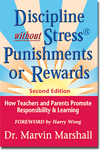|
 |
| Teachers.Net Gazette Vol.6 No.3 | March 2009 |
Subscribe for free home delivery |
|
Habit vs. Awareness for the 3 Practices and for the Hierarchy of Social Development Once something becomes a habit, awareness of it decreases. | |
| by Dr. Marvin Marshall www.MarvinMarshall.com Regular contributor to the Gazette March 1, 2009 |
|
|
 I am on the 2nd year of implementation of the Hierarchy of Social Development. I am an elementary character/p.e. teacher. This is also the first year of "total school" implementation of Discipline Without Stress and it is going well. I had a thought on adding another level to the hierarchy: Level "E" for excellence--Level E being the daily consistent habit of being on level D. Your thoughts when you can. Thanks. My response: There have been many suggestions for what the levels should be called. However, they all detract from the power of using the letters A, B, C, and D because of the meanings behind the vocabulary. In the hierarchy, Level A and Level B are unacceptable. Level C and Level D are both acceptable. The two lower levels describe BEHAVIORS. The two higher levels describe MOTIVATION. (For the most effective use of the HIERARCHY OF SOCIAL DEVELOPMENT, refer to the opening paragraph and the 8th significant point at Significant Points.) The hierarchy becomes significantly more effective when the focus is on the difference between the motivational levels of C and D. The more you have students reflect on their motivational level, the more effectively the system serves both you and them. When first starting to use the hierarchy, there is a tendency to refer to the level at which the person is “acting” or “behaving.” Since Levels C and D refer to MOTIVATION, rather than behavior, the action may appear to be identical on both levels even though the motivation may be different. For example, some students in a classroom will be applying themselves to receive a good grade (Level C). Others will be applying themselves because they know that putting forth effort in their learning is in their own best interests and is the right thing to do (Level D).
| |
|


 His approach is the only system that is proactive, totally noncoercive, and does not use external manipulatives or threats. He INDUCES students to WANT to act responsibly and WANT to put forth effort to learn.
His approach is the only system that is proactive, totally noncoercive, and does not use external manipulatives or threats. He INDUCES students to WANT to act responsibly and WANT to put forth effort to learn.
